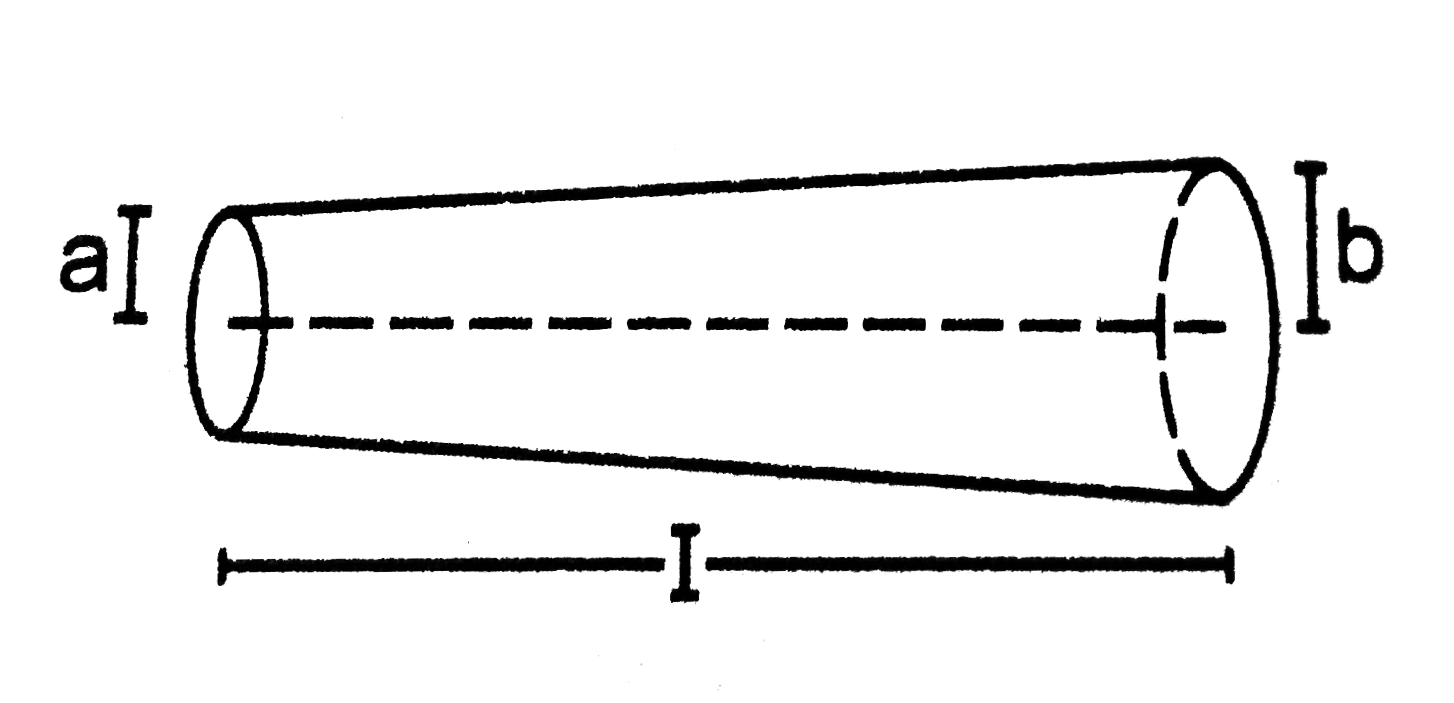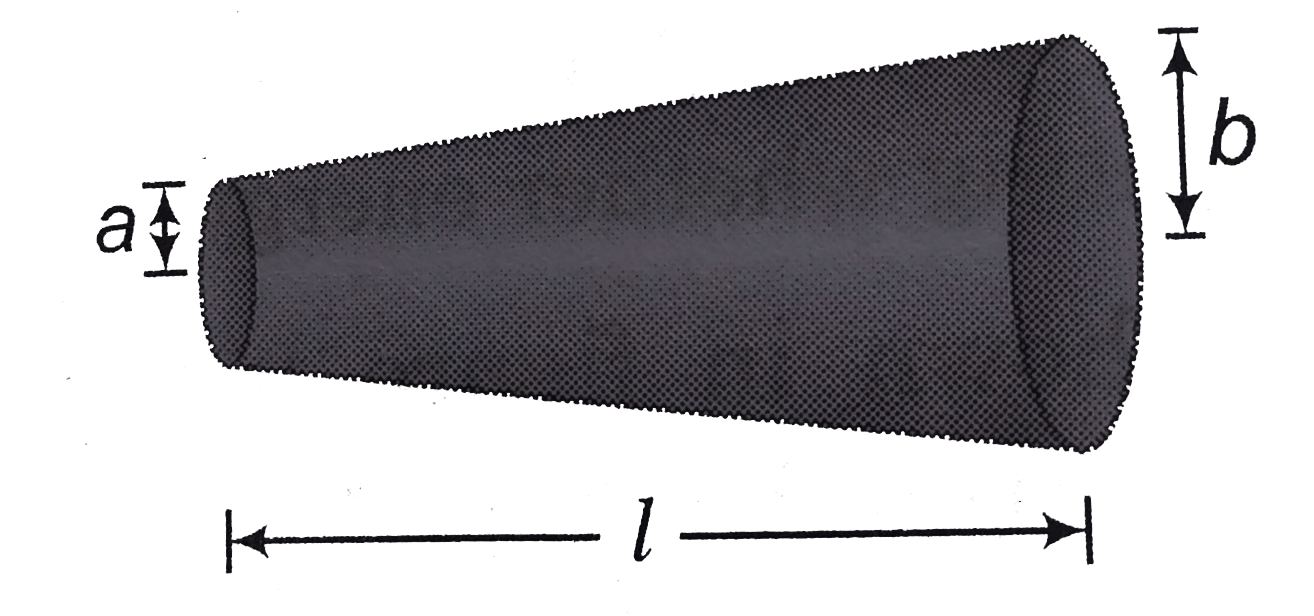Shown a conductor of length l having a circular cross section. The radius of cross section varies linearly form a→b. The resistivity of the material is(ρ).Assuming that b−a<<l,find the resistance of the conductor.
 Solution in Tamil
Solution in Tamil
dRdue→thesmallstripdxatadistance<br>y,R = (rhodx/ y_2)…….(i)<br> tan theta = ((y-a)/x) = ((b-a)/L)<br> rArr ((y-a)/x) = ((b-a)/L)<br> rArr L xx ( y-a) = x(b-a)<br> rArr Ly - La = xb - xa <br> rArr L dy/dx -0 = b-a (diff. w.r. t. x) <br> dx = Ldy/ (b-a)<br>Pu∈gthevalueofdx∈eqn.(i)
dR=(ρLdyπ(y2)(b−a))
dR=(ρLπ(b−a)).dyy2
⇒(∫R0)dR=(ρLπ(b−a))(∫ba)dyy2
R=(ρLπ(b−a))([−1y]ba)
=(ρLπ(b−a))(−1b)(−1a)
(ρLπab).
Topper's Solved these Questions
- ELECTRIC CURRENT IN CONDUCTORSBOOK - HC VERMACHAPTER - ELECTRIC CURRENT IN CONDUCTORSEXERCISE - objective 2
9 Videos
- DISPERSION AND SPECTRABOOK - HC VERMACHAPTER - DISPERSION AND SPECTRAEXERCISE - Exercises
11 Videos
- ELECTRIC CURRENT THROUGH GASESBOOK - HC VERMACHAPTER - ELECTRIC CURRENT THROUGH GASESEXERCISE - Exercise
23 Videos
Similar Questions
Electrons are emitted by a hot filament and are accelerated by an electric field as shown in figure .The two stops at the left ensure that the electron beam has a uniform cross-section.

View SolutionA flint glass prism and a crown glass prism are to be combined in such a way that the deviation of the mean ray is zero. The refractive index of flint and crown glasses for the mean ray are 1.620 and 1.518 respectively. If the refracting angle of the flint prism is 6.0∘, what would be the refracting angle of the crown prism ?
View SolutionA discharge tube contains helium at a low pressure. A large potential difference is applied across the tube. Consider a helium atom that has just been ionized due to the detachment of an atomic electron. Find the ratio of the distance travelled by the free electron to that by the positive ion in a short time dt after the ionization.
View SolutionA conductor of length l has a non-uniform cross-section. The radius of cross-section varies linearly from a to b. The resistivity of the material is ρ. Find the resistance of the conductc across its ends.

View SolutionA cylindrical conductor of length l and uniform area of cross-section A has resistance R. Another conductor of length 2l and resistance R of the same material has area of cross-section :
View SolutionResistivity of the material of a conductor of uniform cross-section varies along its length as rho=rho_(0)(1+alpha x) . Find its resistance if its length is L and area of cross-section is A.
View SolutionResistance of a conductor of length l and area of cross-section A is R. If its length is doubled and area of cross-section is halved, then find its new resistance.
View SolutionFigure shows a conductor of length l having a circular cross-section. The radius of cross-section varies linearly from a to b. Find the resistance of the conductor. ltbtgt
View SolutionWhat is the relation between resistance (R),resistivity(ρ), length(l) and area of cross section (A) of a conductor ?
View SolutionFigure shows a conductor of length l having a circular cross section. The radius of cross section of the conductor varies linearly from r1 to r2 along its length. IF the specific resistance of the material of the conductor be ρ, find the resistance of the conductor.
View SolutionResistivity of a conductor of length l and cross - section A is ρ . If its length is doubled and area of cross-section is halved, then its new resistivity will be .
View SolutionA cylindrical conductor of length l and uniform area of cross-section A has resistance R. Another conductor of length 2l and resistance R of the same material has area of cross-section :
View SolutionResistivity of the material of a conductor of uniform cross-section varies along its length as ρ=ρ0(1+αx). Find the resistance of the conductor, if its length is l and area of corss-section A.
View SolutionResistivity of the material of a conductor of uniform cross-section varies along its length as ρ=ρ0(1+αx). Find the resistance of the conductor, if its length is l and area of corss-section A.
View SolutionA conductor of length l has a non-uniform cross-section. The radius of cross-section varies linearly from a to b . The resistivity of the material is rho . Find the resistance of the conductc across its ends.
View SolutionResistance of a conductor of length l and area of cross-section A is R. If its length is doubled and area of cross-section is halved, then find its new resistance.
View Solution
